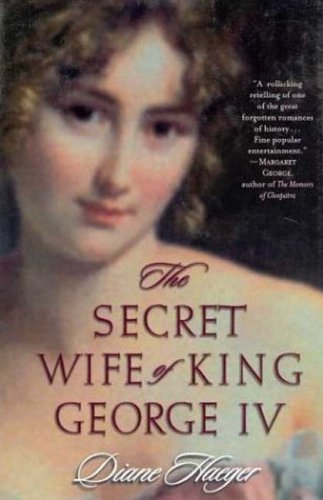The Secret Wife of King George IV
Diane Haeger is no stranger to tales of royal romance, having dramatized the love story of Henri II of France and Diane de Poitiers in her earlier novel Courtesan. In this latest outing she takes on the tale of the turbulent relationship between George IV of England and his secret, illegal wife. In 1784, while still Prince of Wales, George fell in love with twice-widowed Catholic commoner Maria Fitzherbert. In defiance of his father and the Royal Marriages Act, George married Maria in a ceremony kept hidden from his parents, the royal court, and even their closest friends. In short, perfect material for a historical romance.
As the novel begins, her uncle and his social-climbing wife introduce Maria – at 28 and after two marriages still surprisingly innocent – to the intricacies of London society. At a ball she’s presented to the rakish, handsome Prince of Wales, who falls in love with her at first sight. Though reluctant at first, it doesn’t take long for her to reciprocate his feelings… but as a practicing Catholic she refuses to become his mistress.
Keeping an undertaking as a royal marriage a secret is no mean feat, however, as George and Maria soon discover. While all would be perfectly happy to accept her as his mistress, no one is remotely ready to consider the idea of Maria as his wife. Society as a whole comes out in full force against them, so much so that their efforts in holding the union together become difficult to maintain.
Maria Fitzherbert makes an ideal romantic heroine – blonde, beautiful, and graceful, with rarely a hair out of place even in the most distressful situations. Likewise, the Prince of Wales is devilishly handsome, charming, and even reformed from his typical drunken, amorous behavior under Maria’s influence. If these portrayals are a little too perfect to be real, readers should note that this book is primarily a romance, but still I would have liked to see a little less refinement and a little more character development. We’re told that Maria is Catholic, but aside from her protests to that effect and a note sent to Rome, she makes hardly any outward demonstrations of her religion. Also, one introductory scene in which the adult George rather emotionally asks his father why he never loved him is hard to believe. Still, the author has done a good job of recreating a tale of love, duty, and societal pressure against an elegant backdrop of pre-Regency England. Fans of Regency romances who don’t mind some slightly spicy reading will likely enjoy this book.










